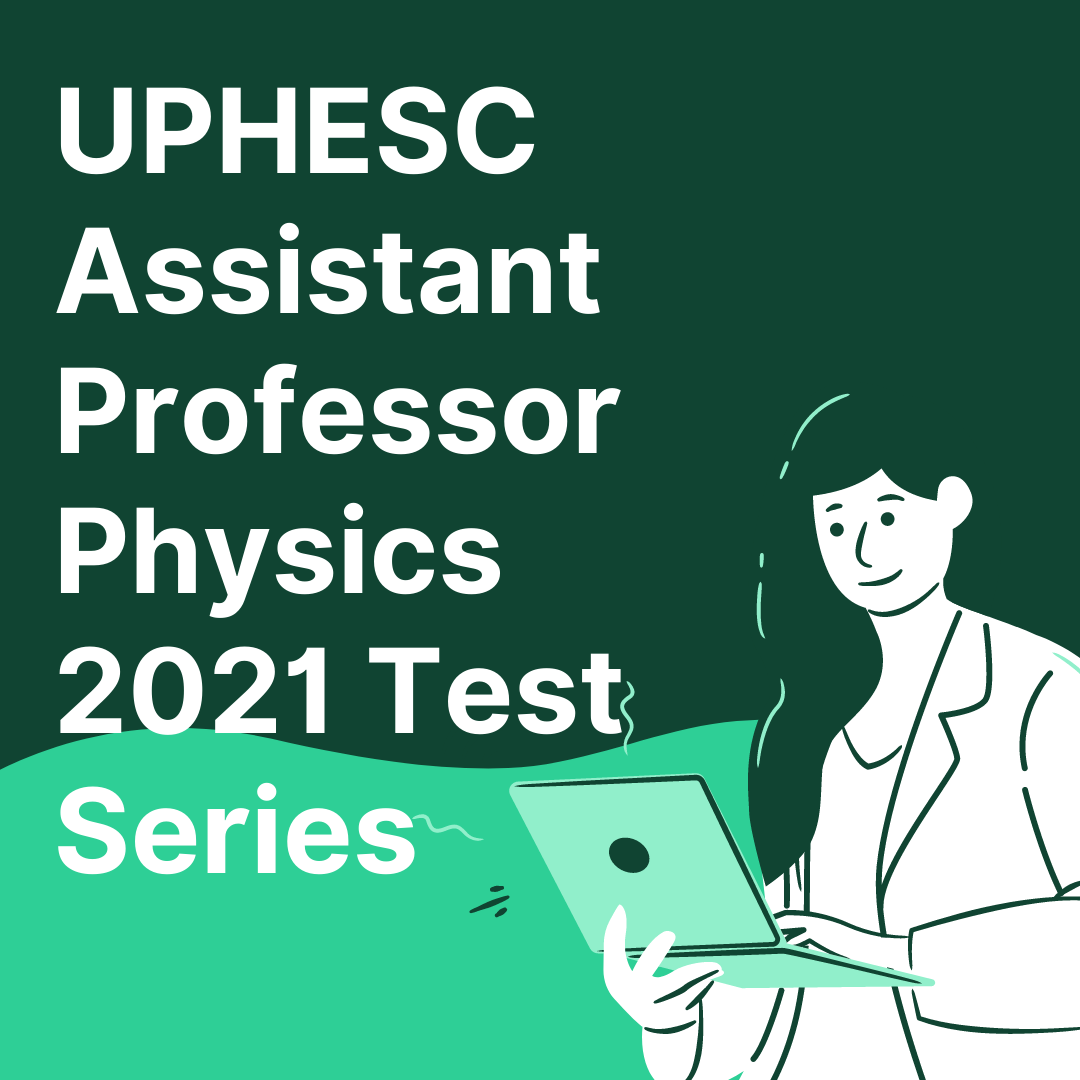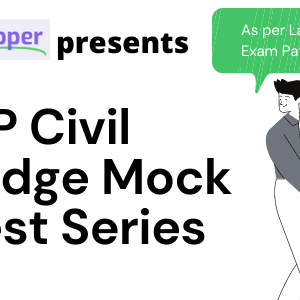Description
UPHESC Assistant Professor Physics 2021 Mock Test series will consists of 10 All UP Mock tests based exactly on the Exam pattern of 100 questions (70 Physics + 30 General Studies). You will be able to check your rank and score among other test takers and your preparation in the competitive exam. Each question is throughly checked and prepared by PhD experts having 10+ years of experience. Accuracy of the questions and answers are verified by tesTopper Team.
UPHESC Physics Exam Test Series 2021 Contents
| Mock Test No. | Video Discussion Link | Availability |
| UPHESC Physics 2021 Mock Test – 01 | Will be available after Test | 5th August |
| UPHESC Physics 2021 Mock Test – 02 | Will be available after Test | 10th August |
| UPHESC Physics 2021 Mock Test – 03 | Will be available after Test | 17th August |
| UPHESC Physics 2021 Mock Test – 04 | Will be available after Test | 25th August |
| UPHESC Physics 2021 Mock Test – 05 | Will be available after Test | 5th September |
| UPHESC Physics 2021 Mock Test – 06 | Will be available after Test | 15th September |
| UPHESC Physics 2021 Mock Test – 07 | Will be available after Test | 30th September |
| UPHESC Physics 2021 Mock Test – 08 | Will be available after Test | 10th October |
| UPHESC Physics 2021 Mock Test – 09 | Will be available after Test | 15th October |
| UPHESC Physics 2021 Mock Test – 10 | Will be available after Test | 20th October |
Topics Covered
I. Mathematical Methods of Physics
Dimensional analysis. Vector algebra and vector calculus. Linear algebra, matrices, Cayley-Hamilton Theorem. eigenvalue problems; Linear differential equations; special functions (Hermite, Bessel, Laguerre and Legendre); Recurrence relations. Fourier series, Fourier and Laplace transforms; Elements of complex analysis: Laurent series-poles, residues and evaluation of integrals; Elementary ideas about thesors; Introductory group theory, SU(2), O(3); Elements of computational techniques: roots of functions, interpolation, extrapolation, integration by trapezoid and Simpson’s rule, solution of first order differential equations using Runge-Kutta method; Finite difference methods; Elementary probability theory, random variables, binomial, Poisson and normal distributions.
II. Classical Mechanics
Newton’s laws; Phase space dynamics, stability analysis; Central-force motion; Two-body collisions, scattering in laboratory and center-of-mass frames; Rigid body dynamics, moment of inertia tensor, Non-inertial frames and pseudoforces; Variational principle, Lagrangian and Hamiltonian formalism and equations of motion; Poisson brackets and canonical transformations; Symmetry, invariance and conservation laws, cyclic coordinates; Periodic motion, small oscillations and normal modes; Special theory of relativity, Lorentz transformations, relativistic kinematics and mass–energy equivalence. Twin Paradox, Hamilton – Jacobi Theory.
III. Electromagnetic Theory
Electrostatics: Gauss’s law and its applications; Laplace and Poisson equations, boundary value problems; Magnetostatics: Biot-Savart law, Ampere’s theorem, electromagnetic induction; Maxwell’s equations in free space and linear isotropic media; boundary conditions on fields at interfaces; Scalar and vector potentials; Gauge invariance; Electromagnetic waves in free space, dielectrics, and conductors; Reflection and refraction, polarization, Fresnel’s law, interference, coherence, and diffraction; Dispersion relations in plasma; Lorentz invariance of Maxwell’s equations; Transmission lines and wave guides; Cavity Resonator, Dynamics of charged particles in
static and uniform electromagnetic fields; Radiation from moving charges, dipoles and retarded potentials Plasma.
IV. Quantum Mechanics
Wave-particle duality; Wave function in coordinate and momentum representations; Commutators and Heisenberg’s uncertainty principle; Matrix representation; Dirac’s bra and ket notation; Schroedinger equation (time-dependent and time-independent); Eigenvalue problems such as particle-in-a-box, harmonic oscillator, etc.; Tunneling through a barrier; Motion in a central potential; Orbital angular momentum, Angular momentum algebra, spin; Addition of angular momenta; Hydrogen atom, spin-orbit coupling, fine structure; Time-independent perturbation theory and Time dependent perturbation theory and Fermi’s Golden Rule; Selection rules; Semi-classical theory of radiation; Elementary theory of scattering, phase shifts, partial waves, Born approximation; Identical particles, Pauli’s exclusion principle, spin-statistics connection; Relativistic quantum mechanics: Klein Gordon and Dirac equations.
V. Thermodynamic and Statistical Physics
Laws of thermodynamics and their consequences; Thermodynamic potentials, Maxwell relations; Chemical potential, phase equilibria; Phase space, micro- and macrostates; Microcanonical, canonical and grand-canonical ensembles and partition functions; Free Energy and connection with thermodynamic quantities; First- and second-order phase transition; Classical and quantum statistics,
ideal Fermi and Bose gases; Principle of detailed balance; Blackbody radiation and Planck’s distribution law; Bose-Einstein condensation; Random walk and Brownian motion; Introduction to non equilibrium processes; Diffusion equation.
VI. Electronics
Semiconductor device physics, including diodes, junctions, transistors, field effect devices, homo and heterojunction devices, device structure, device characteristics, frequency dependence and applications; Optoelectronic devices, including solar cells, photodetectors and LEDs; Highfrequency devices, including generators and detectors; Operational amplifiers and their applications; Digital techniques and applications (registers, counters, comparators and similar circuits); A/D and D/A converters; Microprocessor and microcontroller basics. Oscillator, Amplifier, Modulation & demodulation, Switching time, High frequency devices.
VII. Experimental Techniques and data analysis
Data interpretation and analysis; Precision and accuracy, error analysis, propagation of errors, least squares fitting, linear and nonlinear curve fitting, chi-square test; Transducers (temperature, pressure/vacuum, magnetic field, vibration, optical, and particle detectors), measurement and control; Signal conditioning and recovery, impedance matching, amplification (Op-amp based, instrumentation amp, feedback), filtering and noise reduction, shielding and grounding; Fourier transforms; lock-in detector, box-car integrator, modulation techniques. Application of experimental and analytical techniques.
VIII. Atomic & Molecular Physics
Quantum states of an electron in an atom; Electron spin; Stern-Gerlach experiment; Spectrum of Hydrogen, helium and alkali atoms; Relativistic corrections for energy levels of hydrogen; Hyperfine structure and isotopic shift; width of spectral lines; LS & JJ couplings; Zeeman, Paschen Bach & Stark effect; X-ray spectroscopy; Electron spin resonance, Nuclear magnetic resonance, chemical shift; Rotational, vibrational, electronic, and Raman spectra of diatomic molecules; Frank – Condon principle and selection rules; Spontaneous and stimulated emission, Einstein A & B coefficients; Lasers, optical pumping, population inversion, rate equation; Modes of resonators and
coherence length, U-V and infrared spectrometry.
IX. Condensed Matter Physics
Bravais lattices; Reciprocal lattice, diffraction and the structure factor; Bonding of solids; Elastic properties, phonons, lattice specific heat; Free electron theory and electronic specific heat; Response and relaxation phenomena; Drude model of electrical and thermal conductivity; Hall effect and thermoelectric power; Diamagnetism, paramagnetism, and ferromagnetism; Electron motion in a periodic potential, band theory of solids, Superconductivity: type-I and type-II superconductors. Josephson junctions; Defects and dislocations; Ordered phases of matter, translational and orientational order, kinds of liquid crystalline order; Conducting polymers; Quasicrystals, Quantum Hall effect.
X. Nuclear and Particle Physics
Basic nuclear properties: size, shape and charge distribution, spin and parity; Binding energy, semiempirical mass formula; Liquid drop model; Fission and fusion; Nature of the nuclear force, form of nucleon-nucleon potential; Charge-independence and charge-symmetry of nuclear forces; Isospin; Deuteron problem; Evidence of shell structure, single-particle shell model, its validity and limitations; Rotational spectra; Elementary ideas of alpha, beta and gamma decays and their selection rules; Nuclear reactions, reaction mechanisms, compound nuclei and direct reactions; Classification of fundamental forces; Elementary particles (quarks, baryons, mesons, leptons); Spin and parity assignments, isospin, strangeness; Gell-Mann- Nishijima formula; C,P, and T invariance and application of symmetry arguments to particle reactions, parity non-conservation in weak interaction; Relativistic kinematics.
Test Series Features
- You can also attempt Topic tests by enrolling in to the Online course for UPHESC ASSISTANT PROFESSOR in Physics 2021
- You can also ask your doubt with the tesTopper guru if you have any doubts regarding questions.




Reviews
There are no reviews yet.